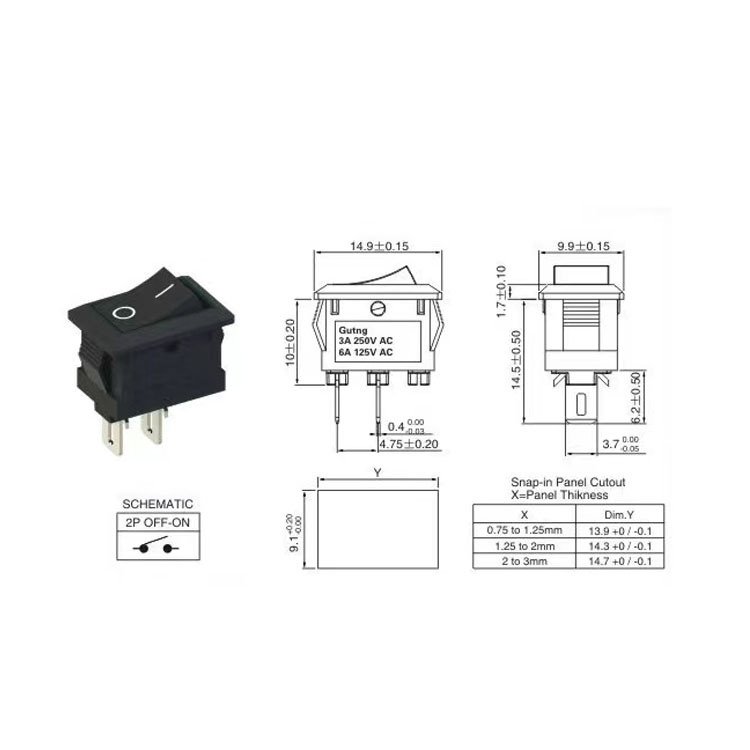
Column:News Release time:2025-02-24 Number of readers:251
In this blog, we will take an in-depth look at three popular types of switches commonly used in various electronic and electrical devices: microswitches, rocker switches, and button switches. We will examine their wiring methods, practical uses, and the role they play in circuits. The goal is to provide you with a comprehensive understanding of how to connect and utilize these switches in your projects.
A microswitch, also known as a snap-action switch, is a small mechanical device that controls a circuit by making or breaking a connection when it is activated. It typically consists of a small lever or button that, when pressed, quickly moves a spring-loaded actuator to either open or close the circuit.
Wiring a Microswitch: As illustrated in the first image, the microswitch has a variety of pin configurations to choose from, depending on the design of the switch. In the diagram, we see a switch with three pins labeled "COM," "NO," and "NC," standing for "Common," "Normally Open," and "Normally Closed," respectively. Here's how you would wire a typical microswitch:

To wire the microswitch, simply connect your input power source to the COM pin, and connect the output (or device being controlled) to either the NO or NC pin, depending on whether you want the circuit to be normally open or closed when the switch is in its resting state.
Practical Applications of Microswitches: Microswitches are commonly used in safety and limit switch applications due to their small size and quick response time. They can be found in devices such as:
The versatility of microswitches makes them indispensable for safety and automation in various industries.
A rocker switch is a simple yet effective device used to control the flow of electricity in a circuit by using a rocking mechanism. When you press one side of the rocker, the switch moves in the opposite direction, either opening or closing the electrical contacts. Rocker switches are very popular in consumer electronics, power strips, and home appliances.
Wiring a Rocker Switch: The second image provides a schematic for wiring a typical two-position rocker switch. Here, the switch has two positions: OFF and ON. The wiring diagram also shows the electrical ratings of the switch, which can handle 3A at 250V AC or 6A at 125V AC. The switch has two terminals for connecting the device and the power source.

The rocker switch is most often used in applications where the user needs to easily switch between two states, such as turning a device on or off. The terminal connections are simple: one side is connected to the input power, and the other side connects to the device being powered.
Practical Applications of Rocker Switches: Rocker switches are commonly used in power control for various household and commercial applications:
The primary advantage of rocker switches is their ease of use and reliable on/off control, making them ideal for everyday electronics.
A button switch is another type of mechanical switch that operates by pressing a button to make or break a connection. There are many types of button switches, including momentary and toggle buttons. The momentary button is only active while being pressed, while the toggle button remains in its selected state until pressed again. The third image shows a button switch wired to power an LED light.
Wiring a Button Switch: The diagram illustrates a simple Push-button connection. The wiring for a button switch can be straightforward. When the button is pressed, the circuit is closed, and current flows to the connected device (e.g., an LED). The wiring setup includes:

The second diagram shows two conditions of the button switch. In the first state (pressing the button), the device is powered on, and the LED lights up. In the second state (releasing the button), the circuit is open, and the device is turned off.
Practical Applications of Button Switches: Button switches are widely used in applications that require user interaction to activate or deactivate a device, such as:
Button switches are very versatile and can be used in various fields ranging from consumer electronics to industrial machines, offering a straightforward way to interface with a system.
In this blog, we have covered the wiring methods and practical uses for microswitches, rocker switches, and button switches. These switches play vital roles in circuits, providing simple yet effective control over electrical flow. Whether you are building a new device, repairing an existing one, or working in industrial automation, understanding how to wire and utilize these switches will be essential to ensure proper functionality and reliability. Each switch type offers distinct advantages for different applications, from safety features in microswitches to simple on/off control in rocker and button switches.